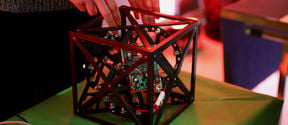Algorithm can create a bridge between Clinton and Trump supporters

A growing number of people have expressed their concern about high levels of polarization in the society. For instance, the World Economic Forum’s report on global risks lists the increasing societal polarization as a threat – and others have suggested that social media might be contributing to this phenomenon. The article that received the best student-paper award in the Tenth International Conference on Web Search and Data Mining (WSDM 2017) builds algorithmic techniques to mitigate the rising polarization by connecting people with opposing views - and evaluates them on Twitter.
The research models user interactions around a given topic such as US elections or Obamacare on Twitter as an endorsement graph, nodes representing the Twitter users. One commonly observed feature of such graphs is that, for controversial topics, the structure of the graph is strongly biclustered. The research suggests bridges between users of opposing sides, so as to effectively minimize the polarization. Bridges can be used to provide users with recommendations about who to retweet.
“We are the first to propose a thoroughly algorithmic solution, which can be applied on a large-scale and is language- and domain-independent. The main algorithm is based on the finding that for a special type of network simulating a polarized network, the best bridges we can add to the network are between the nodes with the highest degrees on either side”, explains professor Aristides Gionis from Aalto University Department of Computer Science.
Possible bridges in the case of US elections
Since the study deals with retweet networks, high-degree users usually are the ones who are well known and have many followers. In the case of US elections, the two sides would be the democrats and republicans and the highest degree users would be Hillary Clinton and Donald Trump on either side, respectively. It is not practical to recommend that Clinton would follow Trump, so even though in theory these are the best edges, they might not materialize in the real world.
“When applied on Twitter discussions around the US election results, the algorithm suggests that creating a bridge between @hillaryclinton and @breitbartnews would reduce polarization the most. However, taking into account how likely such a bridge is to materialize, the algorithm suggests that other bridges between less prominent Twitter accounts, for instance liberal journalist @mtracey and conservative activist @rightwingangel show better potential”, describes researcher Kiran Garimella.
The research approach of Kiran Garimella, Gianmarco De Francisci Morales, Aristides Gionis and Michael Mathioudakis performs better than existing ones, in terms of bringing the two sides closer. Though earlier studies have tried to address the problem of how to recommend content to an ideologically opposite side, researchers of Aalto University, Helsinki Institute for Information Technology HIIT and Qatar Computing Research Institute intend to move from who to what to recommend in their future studies.
More information:
Kiran Garimella
Researcher
Aalto University
[email protected]
Tel. +358 50 430 4933
Aristides Gionis
Professor
Aalto University
[email protected]
Tel. +358 50 430 1651
- Published:
- Updated:
Read more news

Aalto ARTS alum Vidha Samya’s artwork featured at the Venice Biennale 2024
The Pavilion of Finland presents ‘The pleasures we choose’ at the 60th International Art Exhibition – La Biennale di Venezia until 24 November 2024.
IoT Forge donates EUR 1 million to the School of Engineering
The donation will be used for research and education on the Industrial Internet and digital twins.
Join us for the first Aalto Open Science Award Ceremony
All Aaltonians are welcome – no registration required!